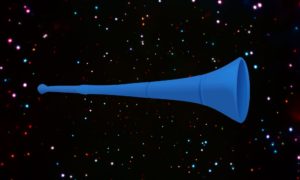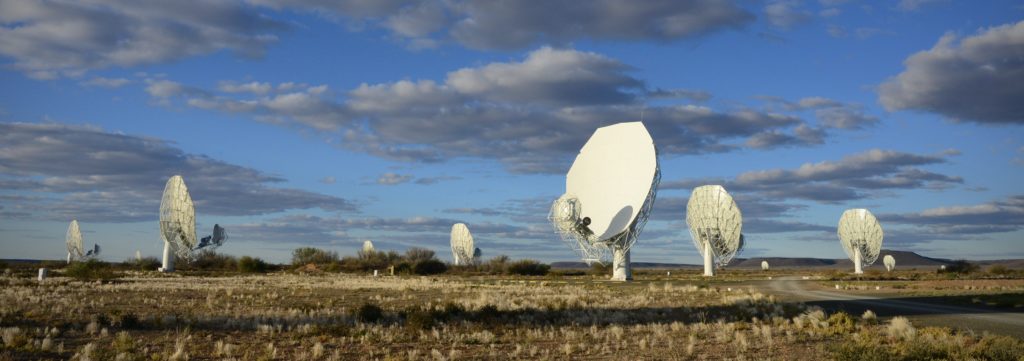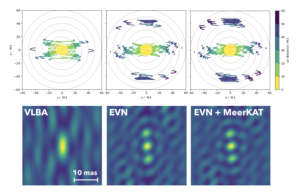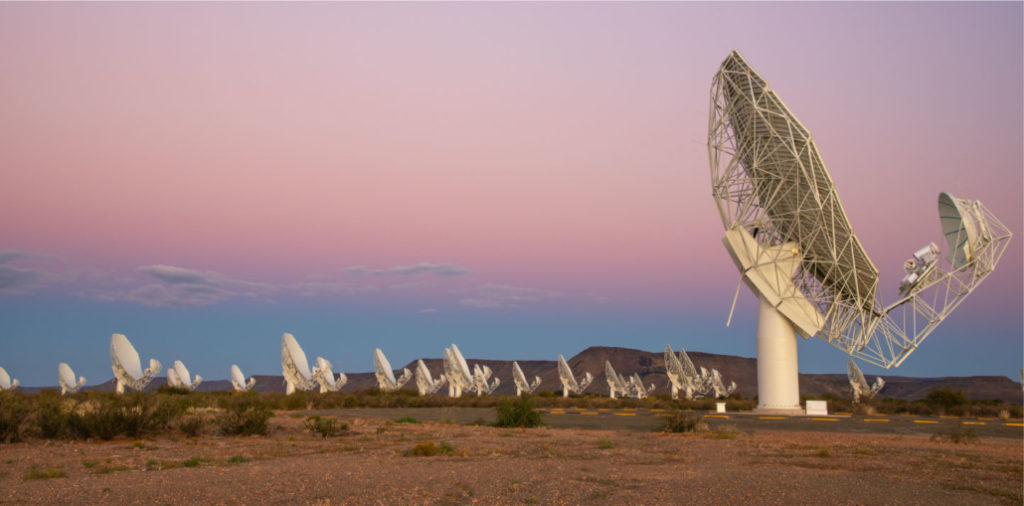A Transient IDIA
Principal Investigators: Patrick Woudt, Rob Fender, Paul Groot
Processing and joint post-processing analytics for ThunderKAT radio and MeerLICHT optical observations.
The MeerLICHT telescope is an optical wide-field telescope that follows MeerKAT on the sky. MeerLICHT makes optical observations of what the MeerKAT is looking at, at the same time. This creates the world’s first so-called optical-radio synoptic survey. MeerLICHT was developed by a consortium of universities, including the University of Cape Town and the South African Astronomical Observatory (SAAO) and supported by the South African Radio Astronomy Observatory (SARAO). The MeerLICHT telescope was inaugurated in May 2018 at the South African Astronomical Observatory in Sutherland and is now in full operation.
As of early 2019, MEERLICHT takes an average of 400 science images per night, adding 100 Gb of data nightly. Astronomical sources are extracted from the images, resulting in a database that grows at a rate of 700 million entries per night.
All raw data from MeerLICHT is transported to IDIA. All data processing is done in the IDIA research cloud environment, and all extracted products are stored on the IDIA system. A web-interface currently in development will allow users to query the database of sources, and retrieve relevant images, including raw data if needed.
HIPPO: HELP-IDIA Panchromatic PrOject
Principal Investigator: Mattia Vaccari
Multi-wavelength data fusion and analysis, machine learning for classification from multi-wavelength data.

The HIPPO project aims to create a cloud-based environment where radio maps and other astronomical catalogues can be effectively combined. In multi-wavelength astronomy, for example, radio observations are combined with optical and infra-red or x-ray observations. Each type of observation complements the others and this helps the study of the evolution of galaxies. The objects identified in each type of light have to be matched. Some are easy like stars, but other sources are extended, like clouds of gas, and this makes the process of combining observations non trivial.
Goals of HIPPO include the development of tools for multi-wavelength source extraction, matching, classification and visualisation to help produce a science exploitation pipeline for MeerKAT extragalactic surveys. The project also aims to determine accurate distances for radio sources by finding corresponding sources in other types of light, which enables the measurement of distances.
An automated source finder, which allows the full radio source characterization workflow to run is nearly complete as of early 2019. Student Wathela Alhassan has published a paper on the morphological classification of Radio Sources using convolutional neural networks.
Data Intensive Astronomy with LADUMA

Principal Investigators: Sarah Blyth, Andrew Baker, Benne Holwerda
LADUMA stands for “Looking At the Distant Universe with the MeerKAT Array”.
The LADUMA survey is one of the MeerKAT large survey projects. LADUMA aims to study galaxy evolution by detecting the neutral hydrogen gas in galaxies far, far away, going back nearly 8 billion years.
In 2018, the LADUMA team has mainly been preparing the data analysis for the survey. This includes imaging of the LADUMA field based on 61 dish test data from MeerKAT. The data processing involves masking of radio frequency interference, imaging and calibration, an important step to understanding the strength of the data.
Another important aspect of the preparatory work focuses on continuum subtraction tests, which allows detection of objects from their specific signature in the electromagnetic spectrum.

HI Intensity Mapping
Principal Investigators: Mario Santos HI (“H one”) is what astronomers call neutral hydrogen gas in the universe. The HI intensity mapping project based at UWC aims to make large maps of the Universe across cosmic time by measuring radio emission from neutral atomic hydrogen in galaxies. This is an essential part of the SKA cosmology science case. From detecting hydrogen in galaxies early in the universe and trying to figure out how it got there, to measuring the total mass of galaxies by observing how the gas swirls around in it, neutral hydrogen is key to understanding many aspects of the formation and evolution of galaxies since the early universe. The mapping relies on statistical detection of the HI signal in emission from galaxies using statistical techniques. Galaxies are not individually detected but their emission over large areas is added up. This uses a new observation mode on MeerKAT where the dishes are moving around the sky very fast.For this reason, the team is developing a specific data reduction pipeline. The project on IDIA relies on 3 “paths”:1) Data calibration, i.e. tuning of the data2) Simulations, where the laws of physics are fed into a computer model and put through a simulation of what the telescope would see.3) Theoretical forecasts, the prediction of what the universe would look like based on physical theories. The data comes straight from SARAO to the IDIA research cloud and goes through the pipeline. The ultimate goal is to make large scale HI cubes to about 5 billion light-years away to test cosmological models. The team at UWC includes• Jingying Wang (postdoc) – calibration• Yi-Chao Li (postdoc) – calibration and simulations• Brandon Engelbrecht (MSc student) – calibration and simulations. Thesis title: “Detecting Baryon Acoustic Oscillations with HI Intensity Mapping using MeerKAT”• Palesa Nombula (MSc student) – simulations. Thesis: “Cleaning HI Intensity Mapping using Machine Learning”• Siyambonga Matshawule (PhD student/staff) – simulations. Thesis: “From MeerKAT to the SKA: Cosmology with HI intensity mapping techniques” Two new MSc students are joining this project soon. In 2018, this project began work in the IDIA Research Cloud. It involved identifying radio frequency interference in the data, calibration, and making maps of the observed regions of the sky. In 2019, MeerKAT data is being analysed using the pipeline developed on IDIA, and large simulations are being run on the research cloud infrastructure.
MeerKLASS preparatory studies

Baryon acoustic oscillations (BAO) are a phenomenon that started? early in the universe as material structures started to form. BAO result in a preferred distance between galaxies that shows up in large optical galaxy surveys, but there is yet to be a radio survey capable of measuring it. The current specifications of the MeerKAT telescope make it a great fit for science applications that require fast survey speeds but not necessarily high-resolution images. MeerKLASS is a proposed project that aims to use MeerKAT survey data mapping neutral hydrogen for the specific purpose of measuring the scale of the baryon acoustic oscillations (BAO). Preparatory studies are used to tune the scientific expectations of such a project. It is hoped that MeerKLASS will measure the scale of BAO with enough accuracy to impose constraints on the nature of dark energy, one of the deepest mysteries of the known universe.
Wide-field Very Long Baseline Interferometry (VLBI)
Principal Investigator: Roger Deane
The technique of Very Long Baseline Interferometry (VLBI) enables radio antennas across the planet to be used as a single, Earth-sized telescope. A single radio telescope may be composed of several elements, but when combined with other radio telescopes far away, the observations become dramatically sharper.
This area of activity focuses mainly on calibration, imaging and analytics of VLBI data sets in view of integrating the MeerKAT, and later the SKA, into the global VLBI network. VLBI is capable of unique types of observation. For example, the recent image of a black hole was only made possible through VLBI techniques.
Artificial Intelligence enhanced wide-field VLBI surveys: precursor science to the full SKA
Artificial Intelligence techniques are growing in importance as the data generated by telescopes increases.

Over the course of the next decade, VLBI arrays will grow in complexity and in sensitivity. The global network will include the MeerKAT and SKA1 mid-frequency dishes. Astronomers will be able to perform so-called wide-field surveys, looking at large parts of the sky. It is expected that new cosmic phenomena, such as strong gravitational lenses, binary supermassive black holes, and other rare objects of high scientific value, will be discovered.
As the number of telescopes and the data rates grow, artificial intelligence is becoming a crucial element in the processing of observations and an enabling tool for new science. This IDIA-supported 3-year project started in 2019. It will pioneer wide-field VLBI observations in combination with tailored artificial intelligence (AI)-driven enhancements.
The project team will develop new data-processing techniques for VLBI. In addition to the science this will enable, the AI component will have broader applications in astronomy and beyond. As a result, this will strategically empower South African researchers with cutting edge technologies and skills.
How galaxies form and evolve
Principal Investigators: Claude Carignan
Analytics and simulations for MONGHOOSE
The MHONGOOSE study is mapping hydrogen gas in a sample of 30 nearby galaxies. Hydrogen gas is nearly everywhere in the Universe, and thanks to MeerKAT, it will be mapped with unprecedented accuracy, unveiling intimate details of galactic and stellar phenomena.
The MeerKAT radio telescope is so sensitive that MHONGOOSE should be able to detect the very thin hydrogen gas connection between galaxies and the vast cosmic web, so far only seen in simulations. In combination with observations in other wavelengths, the hydrogen gas will also be used as a probe to investigate the distribution of different types of matter and how they move around in galaxies.
MeerKAT Open Time projects

Researchers from IDIA partner universities, especially junior researchers, were remarkably successful in gaining access to the MeerKAT telescope for new science projects.
Obtaining observing time on telescopes is a highly competitive process where astronomers have to submit a fully motivated science case. That is, a description of what they want to observe, why it matters, and how they are going to gain new scientific knowledge from the observations. A committee of experts meets and evaluates all the proposed projects. They determine which ones are the most promising, based on their scientific merit and on other aspects, such as the involvement of young astronomers and scientists in training.
In May 2019, the South African Radio Astronomy Observatory announced the results of the first call for such open time projects. Two thirds of the telescope’s first five years of operations are already allocated to eight large survey projects, which were announced in 2017. IDIA already services five of the eight large survey projects. Now those astronomers have successfully bid to use additional MeerKAT time for new science projects. This means more opportunities for young scientists, more scientific discoveries, and lots of big data in need of powerful computing infrastructure in this new age of mammoth scientific experiments.
Prof. Roger Deane from the University of Pretoria has grown his research group substantially in the 2018-2019 year with 7 honours students, 4 Masters students, 1 PhD student and two postdoctoral researchers. They were allocated MeerKAT time to study supermassive black holes at the centre of galaxies. Prof. Deane is also part of the Event Horizon Telescope international team that recently released the first ever image of a black hole.
At the University of the Western Cape, Drs. Asad, Elson, Prescott, Whittam and Profs. Santos and Vaccari all submitted successful proposals. They will investigate galaxies; the hugely complex “megacities” of hundreds of billions of stars, dust, and other matter. UWC researchers will look at a variety of galaxies including those that are giant, interacting, attracting matter from their cosmic environment or varying rapidly.
The University of Cape Town is host to successful projects ranging from examining dying stars to mapping hydrogen gas in the universe and studies of galaxies. These projects are led by senior researchers Prof. Carignan and Groot and, most impressively, by two graduate students, Ms. Julia Healy and Miriam Nyamai, currently studying for their PhDs.
